 Technology peripherals
Technology peripherals
 AI
AI
 New technology Repaint123: Efficiently generate high-quality single-view 3D in just 2 minutes!
New technology Repaint123: Efficiently generate high-quality single-view 3D in just 2 minutes!
New technology Repaint123: Efficiently generate high-quality single-view 3D in just 2 minutes!
The method of converting an image into 3D usually uses the Score Distillation Sampling (SDS) method. Although the results are impressive, there are still several shortcomings, including multi-view inconsistency, over-saturation, Issues such as over-smoothed textures and slow generation speeds.
In order to solve these problems, researchers from Peking University, National University of Singapore, Wuhan University and other institutions proposed Repaint123 to alleviate multi-view bias, texture degradation, and accelerate the generation process.

Paper address: https://arxiv.org/pdf/2312.13271.pdf
GitHub :https://github.com/PKU-YuanGroup/repaint123
Project address: https://pku-yuangroup.github.io/repaint123/
The core idea is to combine the image generation capabilities of the 2D diffusion model with the texture alignment capabilities to produce high-quality multi-view images.
The author further proposes visibility-aware adaptive redraw intensity to improve the quality of the generated image.
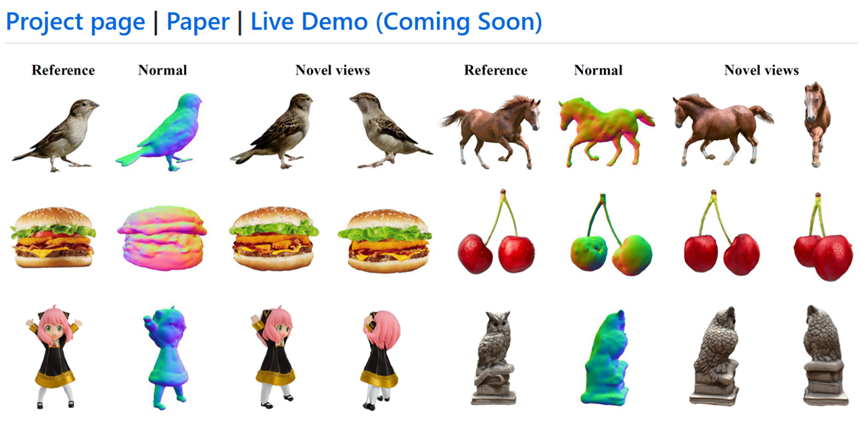
#The generated high-quality, multi-view consistent images enable fast 3D content generation using a simple mean square error (MSE) loss.
The author has experimentally proven that Repaint123 is able to generate high-quality 3D content in 2 minutes, with multi-view consistency and fine textures.
The main contributions of this article are as follows:
1. Repaint123 comprehensively considers the controllable redrawing process from image to 3D generation, and can generate Consistent high-quality image sequences from multiple perspectives.
2. Repaint123 proposes a simple single-view 3D generated baseline. In the coarse model stage, Zero123 is used as the 3D prior and SDS loss to quickly optimize the Gaussian Splatting geometry (1 minute). The fine model The stage uses Stable Diffusion as 2D prior with MSE loss to quickly refine the Mesh texture (1 minute).
3. Extensive experiments have verified the effectiveness of the Repaint123 method, which can generate 3D content matching the quality of 2D generation from a single image in just 2 minutes.
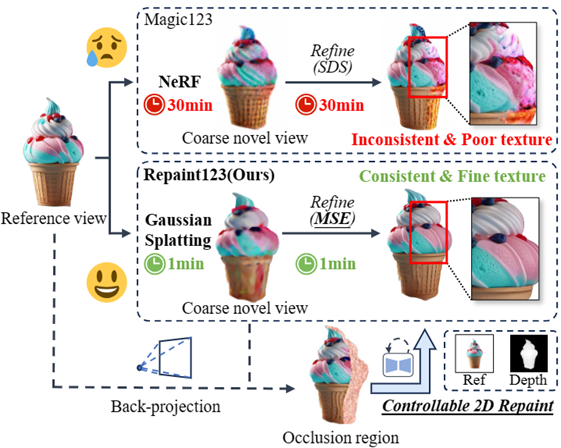
Figure 1: Paper motivation: fast, consistent, high-quality single-view 3D generation
Specific method:
Repaint123’s main improvements focus on the mesh refinement stage, which consists of two parts: consistent high-quality image sequence generation from multiple perspectives, and fast and high-quality 3D reconstruction.
In the rough model stage, the author uses 3D Gaussian Splatting as the 3D representation, and the rough model geometry and texture are optimized through SDS loss.
In the refinement stage, the author converts the coarse model into a mesh representation and proposes a progressive and controllable texture refinement redrawing scheme.
First, the authors gradually redraw the invisible areas relative to the previously optimized view through geometric control and guidance from the reference image, thereby obtaining a view-consistent image of the novel view.
Then, the authors adopt image cues for classifier-free guidance and design an adaptive redrawing strategy to further improve the generation quality of overlapping regions.
Finally, by generating view-consistent high-quality images, the authors leverage a simple MSE loss to quickly generate 3D content.
Multi-viewing consistent high-quality image sequence generation:
As shown in Figure 2, multi-viewing consistent high-quality image sequence generation points It is the following four parts:
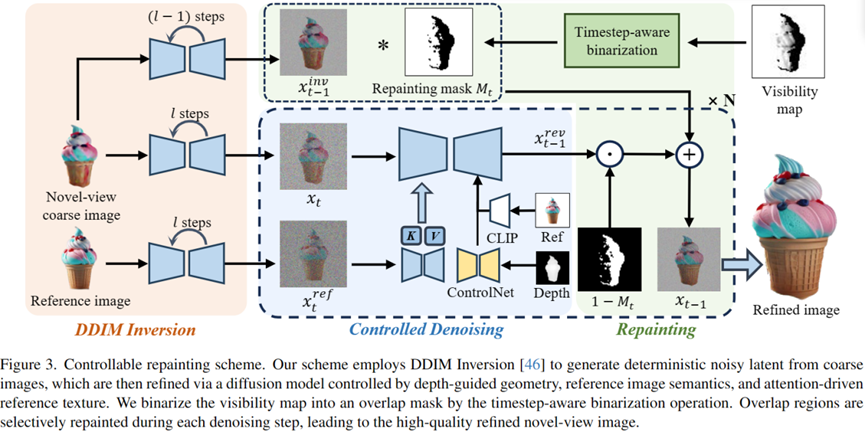
Figure 2: Multi-view consistent image generation process
DDIM Inversion
#In order to preserve the 3D consistent low-frequency texture information generated in the rough model stage, the author uses DDIM Inversion to invert the image to a certain latent for subsequent denoising. Generate faithful and consistent images as a basis.
Controllable Denoising
In order to control the consistency of geometry and long-range texture, in the denoising stage, the author uses ControlNet to introduce the depth map of coarse model rendering as a geometric prior, and injects the Attention feature of the reference map for texture migration.
At the same time, in order to perform Classifier-free guidance to improve image quality, the paper uses CLIP to encode the reference image into an image prompt denoising network.
Obtain Occlusion Mask
To obtain occlusion from a novel view of the rendered image In and depth map Dn Mask Mn, given the redraw reference view Vr of Ir and Dr, the author first scales the 2D pixel points from Vr to the 3D point cloud by using the depth Dr, and then renders the 3D point cloud Pr from the new perspective Vn to obtain the depth map Dn'.
The author considers the area with different depth values between the two novel view depth maps (Dn and Dn') to be the occlusion area in the occlusion mask.
Progressively Repainting both Occlusions and Overlaps
In order to ensure that the overlapping areas of the image sequence and adjacent images are aligned at the pixel level , the author uses a progressive local redrawing strategy to generate harmonious and consistent adjacent areas while keeping the overlapping areas unchanged, and so on from the reference perspective to 360°.
However, as shown in Figure 3, the author found that the overlapping area also needs to be refined, because the visual resolution of an area that was previously strabismus becomes larger when facing directly, and more needs to be added. high-frequency information.
In order to choose the appropriate thinning intensity to ensure fidelity while improving quality, the author draws on the projection theorem and the idea of image super-resolution to propose a simple and direct visibility perceptibility method. The redrawing strategy is used to refine the overlapping area, and the thinning intensity is equal to 1-cosθ* (where θ* is the maximum angle between all previous camera angles and the normal vector of the viewed surface), thereby adaptively redrawing the overlapping area.

Figure 3: Relationship between camera angle and thinning intensity
Fast and high-quality 3D reconstruction :
As shown in Figure 4, the author adopts a two-stage method, first using Gaussian Splatting representation to quickly generate reasonable geometry and rough texture, and at the same time using the multi-view consistent generated above With high-quality image sequences, the authors were able to perform fast 3D texture reconstruction using a simple MSE loss.
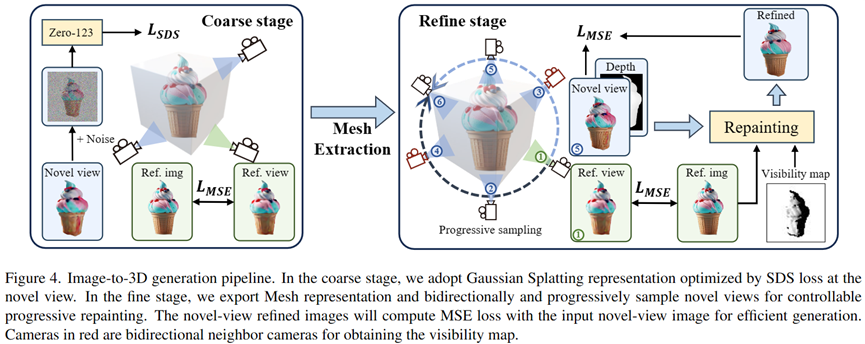
Figure 4: Repaint123 two-stage single-view 3D generation framework
Experimental results
The author compared multiple single-view generation task methods and achieved the most advanced results in terms of consistency, quality, and speed on RealFusion15 and Test-alpha data sets.
Single view 3D generation visualization comparison
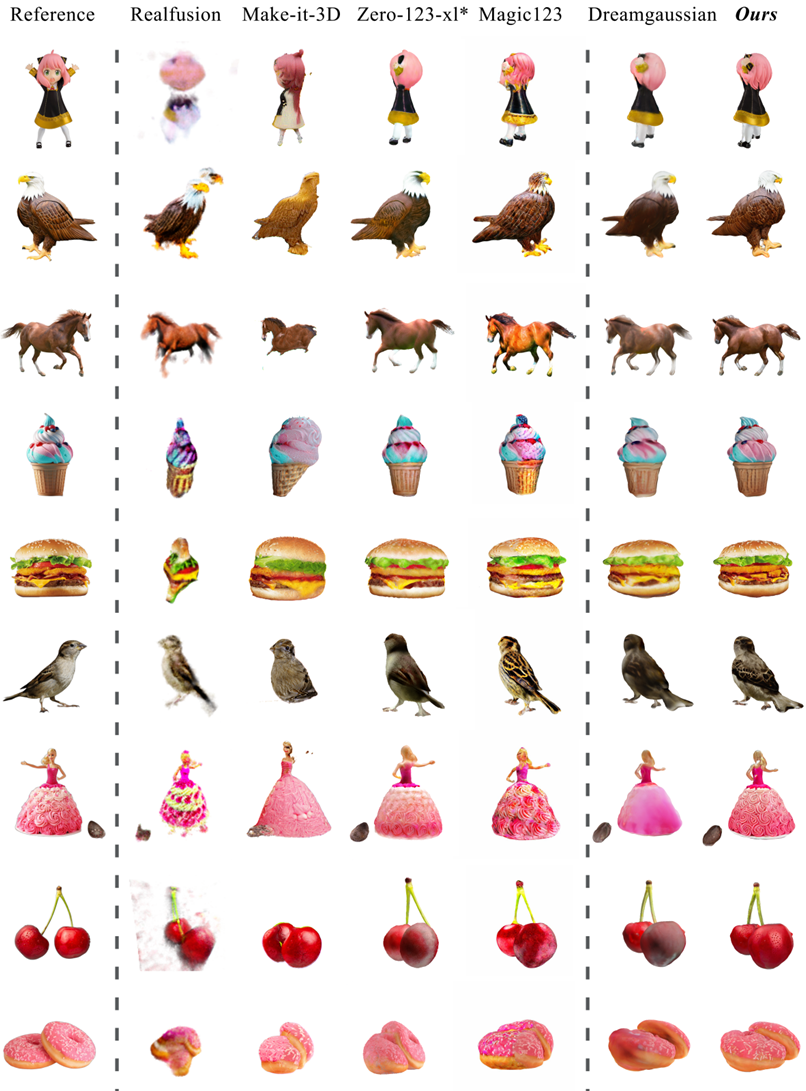
Single view 3D generation quantitative comparison
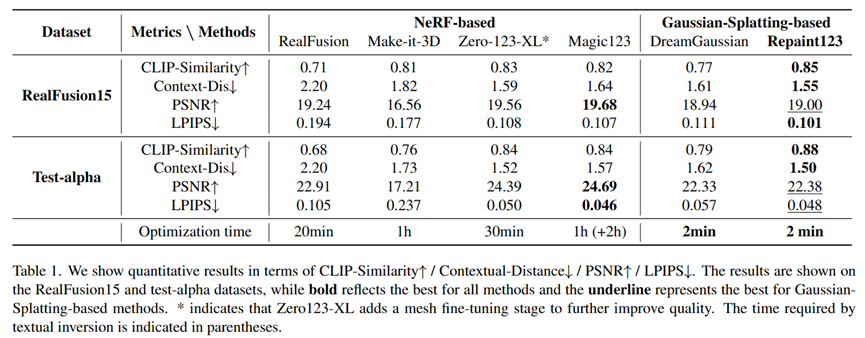
Ablation experiment
At the same time, The author also conducted ablation experiments on the effectiveness of each module used in the paper and the increment of perspective rotation:

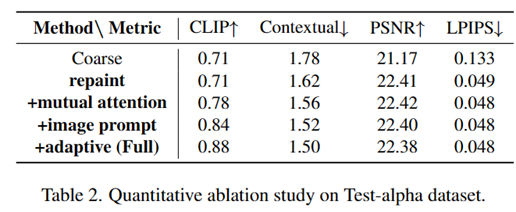
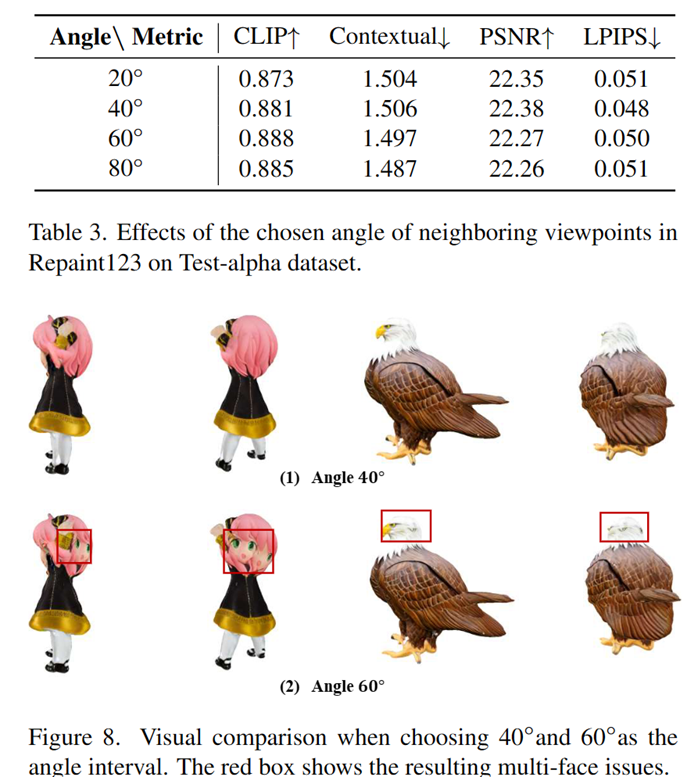
The above is the detailed content of New technology Repaint123: Efficiently generate high-quality single-view 3D in just 2 minutes!. For more information, please follow other related articles on the PHP Chinese website!

Hot AI Tools

Undresser.AI Undress
AI-powered app for creating realistic nude photos

AI Clothes Remover
Online AI tool for removing clothes from photos.

Undress AI Tool
Undress images for free

Clothoff.io
AI clothes remover

AI Hentai Generator
Generate AI Hentai for free.

Hot Article

Hot Tools

Notepad++7.3.1
Easy-to-use and free code editor

SublimeText3 Chinese version
Chinese version, very easy to use

Zend Studio 13.0.1
Powerful PHP integrated development environment

Dreamweaver CS6
Visual web development tools

SublimeText3 Mac version
God-level code editing software (SublimeText3)

Hot Topics
 1378
1378
 52
52
 Open source! Beyond ZoeDepth! DepthFM: Fast and accurate monocular depth estimation!
Apr 03, 2024 pm 12:04 PM
Open source! Beyond ZoeDepth! DepthFM: Fast and accurate monocular depth estimation!
Apr 03, 2024 pm 12:04 PM
0.What does this article do? We propose DepthFM: a versatile and fast state-of-the-art generative monocular depth estimation model. In addition to traditional depth estimation tasks, DepthFM also demonstrates state-of-the-art capabilities in downstream tasks such as depth inpainting. DepthFM is efficient and can synthesize depth maps within a few inference steps. Let’s read about this work together ~ 1. Paper information title: DepthFM: FastMonocularDepthEstimationwithFlowMatching Author: MingGui, JohannesS.Fischer, UlrichPrestel, PingchuanMa, Dmytr
 The world's most powerful open source MoE model is here, with Chinese capabilities comparable to GPT-4, and the price is only nearly one percent of GPT-4-Turbo
May 07, 2024 pm 04:13 PM
The world's most powerful open source MoE model is here, with Chinese capabilities comparable to GPT-4, and the price is only nearly one percent of GPT-4-Turbo
May 07, 2024 pm 04:13 PM
Imagine an artificial intelligence model that not only has the ability to surpass traditional computing, but also achieves more efficient performance at a lower cost. This is not science fiction, DeepSeek-V2[1], the world’s most powerful open source MoE model is here. DeepSeek-V2 is a powerful mixture of experts (MoE) language model with the characteristics of economical training and efficient inference. It consists of 236B parameters, 21B of which are used to activate each marker. Compared with DeepSeek67B, DeepSeek-V2 has stronger performance, while saving 42.5% of training costs, reducing KV cache by 93.3%, and increasing the maximum generation throughput to 5.76 times. DeepSeek is a company exploring general artificial intelligence
 AI subverts mathematical research! Fields Medal winner and Chinese-American mathematician led 11 top-ranked papers | Liked by Terence Tao
Apr 09, 2024 am 11:52 AM
AI subverts mathematical research! Fields Medal winner and Chinese-American mathematician led 11 top-ranked papers | Liked by Terence Tao
Apr 09, 2024 am 11:52 AM
AI is indeed changing mathematics. Recently, Tao Zhexuan, who has been paying close attention to this issue, forwarded the latest issue of "Bulletin of the American Mathematical Society" (Bulletin of the American Mathematical Society). Focusing on the topic "Will machines change mathematics?", many mathematicians expressed their opinions. The whole process was full of sparks, hardcore and exciting. The author has a strong lineup, including Fields Medal winner Akshay Venkatesh, Chinese mathematician Zheng Lejun, NYU computer scientist Ernest Davis and many other well-known scholars in the industry. The world of AI has changed dramatically. You know, many of these articles were submitted a year ago.
 KAN, which replaces MLP, has been extended to convolution by open source projects
Jun 01, 2024 pm 10:03 PM
KAN, which replaces MLP, has been extended to convolution by open source projects
Jun 01, 2024 pm 10:03 PM
Earlier this month, researchers from MIT and other institutions proposed a very promising alternative to MLP - KAN. KAN outperforms MLP in terms of accuracy and interpretability. And it can outperform MLP running with a larger number of parameters with a very small number of parameters. For example, the authors stated that they used KAN to reproduce DeepMind's results with a smaller network and a higher degree of automation. Specifically, DeepMind's MLP has about 300,000 parameters, while KAN only has about 200 parameters. KAN has a strong mathematical foundation like MLP. MLP is based on the universal approximation theorem, while KAN is based on the Kolmogorov-Arnold representation theorem. As shown in the figure below, KAN has
 Hello, electric Atlas! Boston Dynamics robot comes back to life, 180-degree weird moves scare Musk
Apr 18, 2024 pm 07:58 PM
Hello, electric Atlas! Boston Dynamics robot comes back to life, 180-degree weird moves scare Musk
Apr 18, 2024 pm 07:58 PM
Boston Dynamics Atlas officially enters the era of electric robots! Yesterday, the hydraulic Atlas just "tearfully" withdrew from the stage of history. Today, Boston Dynamics announced that the electric Atlas is on the job. It seems that in the field of commercial humanoid robots, Boston Dynamics is determined to compete with Tesla. After the new video was released, it had already been viewed by more than one million people in just ten hours. The old people leave and new roles appear. This is a historical necessity. There is no doubt that this year is the explosive year of humanoid robots. Netizens commented: The advancement of robots has made this year's opening ceremony look like a human, and the degree of freedom is far greater than that of humans. But is this really not a horror movie? At the beginning of the video, Atlas is lying calmly on the ground, seemingly on his back. What follows is jaw-dropping
 Kuaishou version of Sora 'Ke Ling' is open for testing: generates over 120s video, understands physics better, and can accurately model complex movements
Jun 11, 2024 am 09:51 AM
Kuaishou version of Sora 'Ke Ling' is open for testing: generates over 120s video, understands physics better, and can accurately model complex movements
Jun 11, 2024 am 09:51 AM
What? Is Zootopia brought into reality by domestic AI? Exposed together with the video is a new large-scale domestic video generation model called "Keling". Sora uses a similar technical route and combines a number of self-developed technological innovations to produce videos that not only have large and reasonable movements, but also simulate the characteristics of the physical world and have strong conceptual combination capabilities and imagination. According to the data, Keling supports the generation of ultra-long videos of up to 2 minutes at 30fps, with resolutions up to 1080p, and supports multiple aspect ratios. Another important point is that Keling is not a demo or video result demonstration released by the laboratory, but a product-level application launched by Kuaishou, a leading player in the short video field. Moreover, the main focus is to be pragmatic, not to write blank checks, and to go online as soon as it is released. The large model of Ke Ling is already available in Kuaiying.
 The vitality of super intelligence awakens! But with the arrival of self-updating AI, mothers no longer have to worry about data bottlenecks
Apr 29, 2024 pm 06:55 PM
The vitality of super intelligence awakens! But with the arrival of self-updating AI, mothers no longer have to worry about data bottlenecks
Apr 29, 2024 pm 06:55 PM
I cry to death. The world is madly building big models. The data on the Internet is not enough. It is not enough at all. The training model looks like "The Hunger Games", and AI researchers around the world are worrying about how to feed these data voracious eaters. This problem is particularly prominent in multi-modal tasks. At a time when nothing could be done, a start-up team from the Department of Renmin University of China used its own new model to become the first in China to make "model-generated data feed itself" a reality. Moreover, it is a two-pronged approach on the understanding side and the generation side. Both sides can generate high-quality, multi-modal new data and provide data feedback to the model itself. What is a model? Awaker 1.0, a large multi-modal model that just appeared on the Zhongguancun Forum. Who is the team? Sophon engine. Founded by Gao Yizhao, a doctoral student at Renmin University’s Hillhouse School of Artificial Intelligence.
 The U.S. Air Force showcases its first AI fighter jet with high profile! The minister personally conducted the test drive without interfering during the whole process, and 100,000 lines of code were tested for 21 times.
May 07, 2024 pm 05:00 PM
The U.S. Air Force showcases its first AI fighter jet with high profile! The minister personally conducted the test drive without interfering during the whole process, and 100,000 lines of code were tested for 21 times.
May 07, 2024 pm 05:00 PM
Recently, the military circle has been overwhelmed by the news: US military fighter jets can now complete fully automatic air combat using AI. Yes, just recently, the US military’s AI fighter jet was made public for the first time and the mystery was unveiled. The full name of this fighter is the Variable Stability Simulator Test Aircraft (VISTA). It was personally flown by the Secretary of the US Air Force to simulate a one-on-one air battle. On May 2, U.S. Air Force Secretary Frank Kendall took off in an X-62AVISTA at Edwards Air Force Base. Note that during the one-hour flight, all flight actions were completed autonomously by AI! Kendall said - "For the past few decades, we have been thinking about the unlimited potential of autonomous air-to-air combat, but it has always seemed out of reach." However now,



